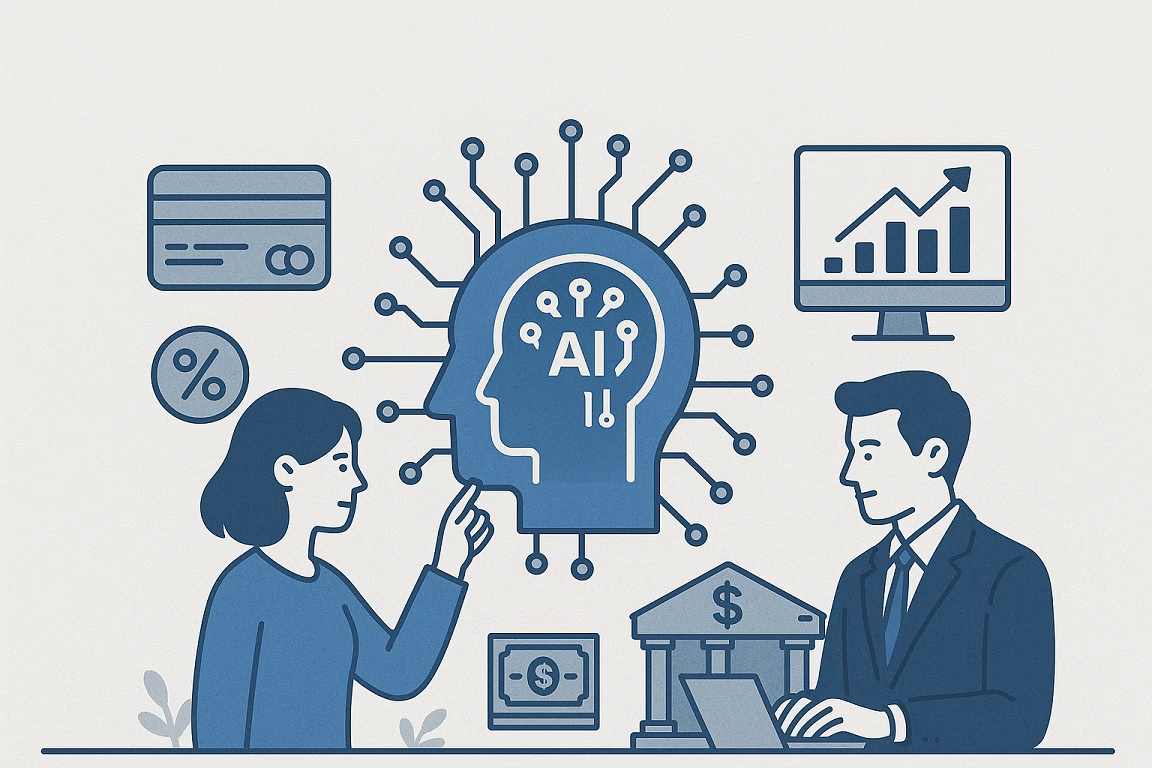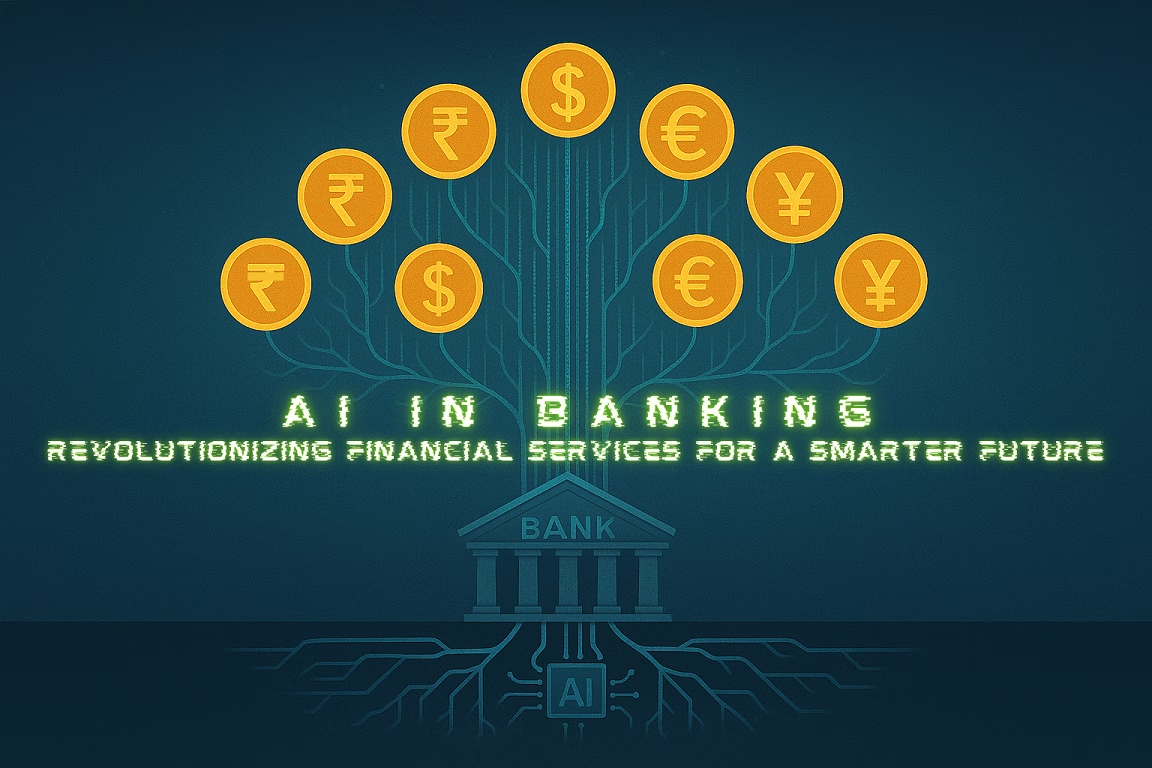Introduction:
Before we delve into the impact of Artificial Intelligence (AI) in the banking sector, we need to know what AI is. In simple terms, AI refers to computational systems that traditionally require human intelligence, such as learning, reasoning, and problem-solving. AI has become a transformative force in the banking sector through advances in machine learning, natural language processing, and robotic process automation. As financial institutions embrace digital transformation, AI serves as a cornerstone for innovation, efficiency, and competitive advantage. These technological adaptations enable banks to rapidly process large amounts of data, manage risks more efficiently, gain actionable insights, and provide personalized services at scale. This blog explores the key applications, real-world impacts, challenges, and future trends of AI in banking.
Table of Contents
Evolution of AI in Banking:
Early use of AI in banking focused on rule-based systems for tasks such as credit scoring and Automated Teller Machine (ATM) monitoring. Over time, the convergence of big data, cloud computing, and more sophisticated algorithms has led to the use of advanced AI in front, middle, and back-office operations. Consulting firms note that while initially limited to high-frequency trading and fundamental analysis, banks today use AI in many functions, including customer engagement, risk modelling, compliance, and beyond.
Key Applications of AI in Banking:
The use of AI in banking is versatile. Below are the most impactful use cases:
Fraud Detection and Cybersecurity:
Financial fraud costs banks billions of rupees every year due to growing threats such as identity theft, phishing, and transaction fraud. To combat this, banks use Machine Learning (ML) models such as supervised and unsupervised learning for real-time anomaly detection, analyzing transaction patterns to identify suspicious activity. Generative AI (GenAI) complements these efforts by simulating fraudulent scenarios to train detection systems, for example, synthetic voice or image detection in phishing attempts through deepfake detection tools. Behavioural biometrics adds another layer of security by authenticating users based on unique behavioural patterns such as typing speed or mouse movements. Technologies such as deep learning, neural networks, and Natural Language Processing (NLP) power these systems, as demonstrated by Danske Bank’s deep learning tool that reduced false positives by 60%.
Customer Service and Chatbots:
The constant high volume of queries puts a strain on human agents, causing delays and customer dissatisfaction. Banks are using Natural Language Processing (NLP) to power chatbots that understand context, slang, and multilingual questions, while sentiment analysis identifies customer emotions (e.g., frustration) and relays complex issues to human agents. Omnichannel integration ensures that AI assistants work seamlessly across platforms such as apps, websites, and social media.
Supported by technologies like reinforcement learning and speech recognition, tools like Bank of America’s Erica handle over 50 million annual requests, assisting with balance checks, bill payments, and financial advice, and HDFC’s EVA (Electronic Virtual Assistant) is India’s first AI-based banking chatbot that can answer multiple customer queries within fraction of a second.
Risk Management and Credit Decisions:
Traditional credit scoring excludes disadvantaged populations (e.g., those without a formal credit history) and relies on outdated and conventional data, perpetuating financial inequality. To address this, alternative data analytics assess creditworthiness by evaluating non-traditional factors such as rent payments, utility bills, and even social media behaviour. Predictive analytics uses dynamic models, which are updated with real-time data (e.g., changes in income or spending habits), to predict default risk more accurately. Stress testing assesses loan portfolio resilience by simulating economic downturns, ensuring that lenders can withstand market shocks. Technologies such as decision trees, gradient boosting, and time-series forecasting strengthen these systems, as seen at Capital One, which reduced default rates through AI-optimized underwriting.
Increased Efficiency in Banking Operations:
Manual, repetitive tasks like data entry and compliance checks slow down banking operations, leading to inefficiencies and delays. Robotic Process Automation (RPA) automates workflows like account opening and Know Your Customer (KYC) verification. At the same time, document processing tools combine computer vision and NLP to extract data from contracts, IDs, or handwritten forms. AI-powered coding accelerates software development, increasing IT productivity. In a word, AI has greatly increased the efficiency of the banking sector by making its tasks easier and less time-consuming.
Personalized Customer Services:
One-size-fits-all financial products fail to meet the needs of diverse customers. Different customers have different needs, so a variety of financial products is essential to meet all types of needs. To overcome this problem, banks deploy recommendation engines to analyse transaction history and customer life goals, product suggestions (e.g., loans, insurance), predictive analytics to predict needs, and clustering algorithms for customer segmentation and targeted marketing. Powered by collaborative filtering and reinforcement learning, tools like Erste Bank’s George (Personalized Savings Tips) achieve 30-40% higher product conversion rates and stronger customer loyalty through hyper-personalized experiences.

Benefits of AI in Banking:
The benefits of AI in banking are as follows:
Saves Time and Money:
Repetitive tasks like data entry, transaction processing, and compliance checks have been automated with AI. It slashes the operational costs of banking by up to 30%, while the AI-driven chatbots reduce call centre expenses by 30-50%.
Uninterrupted Customer Service:
AI-driven chatbots and other automated services provide support 24/7. Chatbots like HDFC’s EVA resolve millions of queries instantly without any interruption. This enhances customer satisfaction and reliability. For example, ask a chatbot at 3 a.m., “What’s my account balance?”, and it answers instantly.
Reduce Fraudulent Activities:
AI monitors transactions in real time and identifies unusual patterns (e.g., sudden large withdrawals). Real-time anomaly detection and behavioural biometrics cut fraud losses by 50%.
Faster and Fairer Loan Disbursement:
AI evaluates customers’ credit scores, income, and related information more efficiently, enabling banks to approve or reject loans faster. AI also analyses non-traditional information to determine customer creditworthiness, making loan disbursement fairer.
Improved Risk Management:
Predictive analytics, which uses a dynamic model updated with real-time data, along with alternative data, enables fairer credit decisions. This, in turn, reduces the risks of loan non-repayment, as demonstrated by Upstart’s 27% increase in loan approvals.
Regulatory Compliance:
Regulations such as the General Data Protection Regulation (GDPR) and Anti-Money Laundering (AML) require significant compliance resources. AI solutions support automated monitoring with NLP to scan documents for non-compliance, and risk scoring to assess client risk from transaction patterns. Key technologies include NLP, graph analytics, and blockchain. For example, HSBC’s AML AI has reduced false positives by 20%, while Goldman Sachs’ compliance engine automates 75% of compliance checks. This results in faster audits, reduced fines, and a 50% reduction in manual workload for compliance teams.

Challenges and Mitigations:
While the use of AI in banking has brought benefits to banking services, it also has some drawbacks. Some of the notable drawbacks and the way to mitigate them are discussed below:
Data Privacy and Security:
Banks process and store highly sensitive and important financial and personal data, making them prime targets for cyberattacks and privacy breaches. Keeping them secure throughout their lifecycle, i.e., at rest, in transit, and during model training, is a major challenge, further compounded by the use of third-party clouds and cross-border data flows under different regulatory regimes.
To mitigate these risks, institutions like banks and other financial institutions use end-to-end encryption, set up secure enclaves for model training, implement data anonymization and differential privacy strategies, and adopt strong access controls through zero-trust architectures. A robust data governance framework, combined with regular security audits and penetration testing, ensures compliance with GDPR and domestic data protection laws (such as the Digital Personal Data Protection Act, 2023 in India).
Algorithmic Bias and Fairness:
AI models can inadvertently perpetuate or amplify historical biases in the training data, leading to discriminatory lending decisions that harm vulnerable groups. Identifying and correcting bias requires a lifecycle approach: pre-processing data to balance representation, in-process modifications, and post-processing adjustments such as threshold calibration. Deploying interpretable AI tools provides transparency into the importance of features, while continuous fairness audits track metrics such as disparate impact and equal opportunity. Interdisciplinary review committees, inclusive data collection practices, and embedded bias mitigation algorithms help the AI models make fair lending decisions.
Model Drift and Performance Maintenance:
AI models degrade over time as borrower behaviour and macroeconomic conditions evolve – a phenomenon known as model drift. If not controlled on time, model drift reduces predictive accuracy, leading to poor risk assessment and higher default rates.
Effective mitigations include implementing real-time monitoring dashboards that track AI model performance, automated data-drift detection tools to identify distributional changes, and a model retraining pipeline. Root cause analysis capabilities identify drift drivers, such as changes in unemployment rates or payment patterns, enabling timely data and feature updates.
Talent and Cultural Adoption:
Deploying and managing AI in banking requires a multidisciplinary team of data scientists, compliance specialists, and domain experts. Yet 68 percent of IT leaders cite insufficient skills as a primary barrier to AI projects.
To build AI maturity, banks need to invest in continuous skill-building programs, build university-industry partnerships, and recruit talent through specialized graduate programs. Building a culture of ethical innovation supported by the AI Ethics Council and cross-departmental collaboration, ensuring that technological advancements are aligned with organizational values and regulatory expectations.
Conclusion:
AI in banking is no longer a futuristic concept – it is a present-day catalyst that is transforming the banking sector from the ground up. In areas such as credit scoring and loan underwriting, artificial intelligence enables more accurate risk assessment, faster decision-making, and greater financial inclusion (including vulnerable groups). By leveraging vast data sources and deploying sophisticated machine learning models, banks can serve customers more efficiently. However, with these advances come important responsibilities: ensuring data privacy, reducing algorithmic bias, maintaining regulatory compliance, and tackling model drift are essential for sustainable AI adoption. As the banking sector evolves, banks that prioritize innovation, transparency, and continuous learning will be best positioned to thrive in this intelligent financial era.


